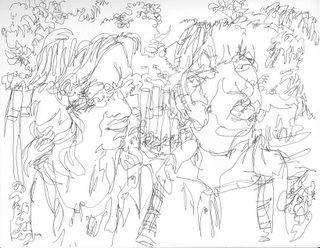Monday, January 30, 2006
Sunday, January 29, 2006
Friday, January 27, 2006
Wednesday, January 25, 2006
Monday, January 23, 2006
Sunday, January 22, 2006
Saturday, January 21, 2006
Friday, January 20, 2006
Thursday, January 19, 2006
Wednesday, January 18, 2006
Monday, January 16, 2006
Sunday, January 15, 2006
Saturday, January 14, 2006
Friday, January 13, 2006
Thursday, January 12, 2006
Wednesday, January 11, 2006
Tuesday, January 10, 2006
The idea for Contouring Quebec began in 2004 during a drawing workshop I held in
Monday, January 09, 2006
Artist’s Statement
Since completing my thesis in Drawing at the
I collect these precious objects that I make as a way of recording my existence. My largest collection of drawings uses the discipline of blind contour drawing, a technique which attempts to capture the fast moving modern world in which we live.
Seurat said that drawing is the probity of art. In this regard, it is no wonder that drawing is one of the first activities that children occupy themselves with. In early childhood, drawing is often a mimetic process, where the child mimics an older sibling or adult’s movements, and quite often the drawings are nothing more than scribbles. These scribbles mimetic properties describe the subjectivity that children and adults use see the world. These drawings describe perception and imperception, or what is real and that which is not. Drawing is a process used to describe that amnesis, or that which can be remembered in the moment where an artist sees and an artist draws.
Blind contour drawing eliminates the amnesis, or memory requirement, that regular drawing creates. In a similar discussion, but about painting photographs, Gerhard Richter states he removes conscious thinking by the act of reproducing what he sees in a photograph. It is much the same with blind contour drawing, where conscious thinking is replaced with hand and eye representation. Following the contours of what is seen, but not looking at what is represented, allows the hand to “feel” the environment.
I collect these drawings of my environment and they become my personal nostalgia. Collecting represents the most rudimentary way to exercise control over the outer world: by laying things out, grouping them, handling them.” I relentlessly draw my surroundings, enjoying the knowledge of this self pleasure, this self-knowing. It is “the joy of finding one’s self that exists outside the world around us” (Baudrillard).





















